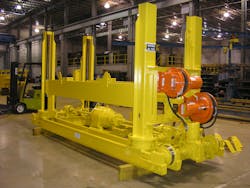A veteran railway lift table so tough it survived the Hurricane Katrina floods in New Orleans to be dried out and returned to use was finally retired after 66 years of service and replaced by the latest version of the same heavy duty table from the same lifting equipment manufacturer, Whiting Corporation.
The original 60-ton four-screw lift table in the Amtrak New Orleans Maintenance Facility entered service in 1949, and was already a seasoned veteran by the time of the official formation of the Amtrak in 1971.
It went on to provide decades more of dependable service for Amtrak until the table was submerged for two weeks when the maintenance facility, along with much of New Orleans, was struck by Hurricane Katrina in 2005.
“It speaks volumes for the durability of the product and the robust manufacturing of its mechanical and electrical components that only required minimal work to bring the Drop Table back online after being submerged for two weeks. Before being placed back into service, the four lifting screws were regreased and the motors were rewound. After that, it was placed back into the pit and ran for another 10 years,” said Edward Yakos, senior vice president for Chicago-based Whiting Corporation.
The new 60-ton four screw Drop Table now in service for Amtrak New Orleans retains the core strengths of the original, but adds significant electrical and mechanical upgrades like variable-frequency drives and automatic lubrication systems. These upgrades offer safer control of the table, reduce maintenance costs, and increase the overall reliability of the Drop Table.
“The old Amtrak Drop Table, which completed more than 60 years’ service before it was retired, reflected Whiting’s role as a pioneer of this type of technology,” said Yakos. “It is a compliment to the Whiting engineers in the 1940s who built Whiting products on such a strong foundation, providing technology that served reliably through a period of massive expansion of Amtrak services. This quality design, engineering and manufacturing tradition continues today.”
Whiting custom-engineered Drop Tables set reliability and safety standards for removing single axles or full trucks from railcars and locomotives. Whiting engineers take the time to understand the unique application aspects to provide custom lifting solutions for rail shops across North America.
Whiting Corporation’s customer base extends from rail lifting and maintenance technology to custom-engineered overhead cranes for many of North America’s largest manufacturers and leading public utilities. Customers include nuclear and general power generation, automotive and aircraft manufacturing, space exploration and diverse manufacturing and materials handling industries requiring equipment that won’t quit when the going gets tough. The Whiting name has been trusted by many of North America’s leading manufacturing and rail organizations for more than 100 years.
What is a Drop Table?
A Drop Table is used to change out single axle wheel sets or full trucks on railcars and locomotives. Using two sets of tracks, the drop table lowers one set of wheels/truck from the engine positioned on the maintenance track, and moves underground on rails before rising up to connect with a release track. While the wheels are lowered, the locomotive or rail car may be supported by body supports.
From there, the wheel set is repaired or a new set is rolled onto the table. The Drop Table then lowers and returns to the maintenance track where it raises the wheel set back into place. This process makes wheel set change outs quick, efficient, and cost effective.
Whiting’s time tested designs include rugged body supports and girders, remote operated consoles, a range of customized capacities, self-locking jack screws and optional release track tops.


